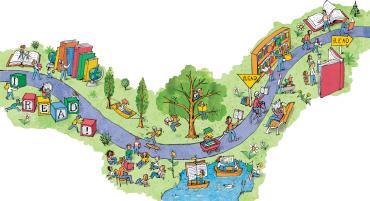For more than two decades—and continuing in this issue—American Educator has followed the research on how to maximize each child’s chance of becoming a strong reader. The two biggest takeaways this collection of articles offers are that we must (1) provide enough explicit instruction and practice to ensure that students learn to sound out words fluently, and (2) immerse young students in learning history, science, literature, and the arts so that they develop the keys to comprehension: broad knowledge and a rich academic vocabulary.
–Editors
“To be successful, children need to learn both code and content knowledge. Code-related skills, like the essential alphabetic principles that make up our language, are a critical component in learning to read. But while these skills are necessary, they are certainly not sufficient. They must be accompanied by a massive, in-depth, and ever-growing foundation of factual knowledge.”
–Susan B. Neuman, “Sparks Fade, Knowledge Stays,” Fall 2010
“The ability to sound out new words accounts for about 80 percent of the variance in first-grade reading comprehension, and continues to be a major factor in text comprehension as students progress through the grades.... Systematic, explicit instruction leaves little to chance and thus ensures the success of most children.”
–Louisa C. Moats, “Teaching Decoding,” Spring/Summer 1998
“Without direct instructional support, phonemic awareness eludes roughly 25 percent of middle-class first graders and substantially more of those who come from less literacy-rich backgrounds.”
–Marilyn Jager Adams, Barbara R. Foorman, Ingvar Lundberg, and Terri Beeler, “The Elusive Phoneme,” Spring/Summer 1998
“Researchers have estimated that the spellings of nearly 50 percent of English words are predictable based on sound-letter correspondences that can be taught (e.g., the spellings of the /k/ sound in back, cook, and tract are predictable to those who have learned the rules). And another 34 percent of words are predictable except for one sound (e.g. knit, boat, and two).”
–R. Malatesha Joshi, Rebecca Treiman, Suzanne Carreker, and Louisa C. Moats, “How Words Cast Their Spell,” Winter 2008–2009
“Some children are able to develop letter-sound knowledge more quickly and efficiently than others.... An important direction for our field is to work toward determining the most time-efficient approaches to ensuring each child in a class meets grade-level expectations in word reading each year.”
–Nell K. Duke and Heidi Anne E. Mesmer, “Phonics Faux Pas,” Winter 2018–2019
“How can children ‘read to learn’ when they are still learning to decode text independently? The answer is that adults read aloud to them.”
–Tanya S. Wright, “Reading to Learn from the Start,” Winter 2018–2019
“Those who enter 4th grade with significant vocabulary deficits show increasing problems with reading comprehension, even if they have good reading (word identification) skills. The available evidence does not suggest a substantial ‘catching-up’ process, but rather a continuing slippage relative to those with average and above-average achievement.”
–Andrew Biemiller, “Oral Comprehension Sets the Ceiling on Reading Comprehension,” Spring 2003
“Background knowledge and vocabulary, along with fluent decoding ability, [are] at the center of reading comprehension.”
–E. D. Hirsch, Jr., “Building Knowledge,” Spring 2006
“We must organize our readings in every subject so each text bootstraps the language and knowledge needed for the next. Gradually, students will be ready for texts of greater complexity.”
–Marilyn Jager Adams, “Advancing Our Students’ Language and Literacy,” Winter 2010–2011
“Research shows that telling parents about research-based practices in reading does lead to improvement in children’s reading.”
–Daniel T. Willingham, “For the Love of Reading,” Spring 2015

